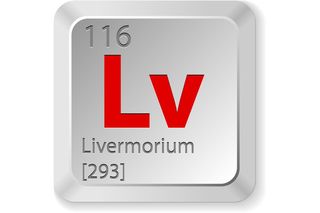Facts About Livermorium

Atomic Number: 116 Atomic Symbol: Lv Atomic Weight: [293] Melting Point: Unknown Boiling Point: Unknown
Word origin: Livermorium is named for the Lawrence Livermore National Laboratory in California. The name was officially given by the International Union of Pure and Applied Chemistry on May 31, 2012; prior to that, it was known as ununhexium — one-one-six in Latin.
Discovery: Livermorium was created by scientists at the Joint Institute for Nuclear Research in Dubna, Russia, in 2000. On December 6 of that year, it was jointly announced by the Russian scientists and scientists at the Lawrence Livermore National Laboratory.
Properties of livermorium
Livermorium is a radioactive, artificially produced element about which little is known. It is expected to be a solid and classified as a metal. It is a member of the chalcogen group.
Livermorium has four isotopes with known half-lives, all of which decay through alpha decay. The most stable is 293Lv with a half-life of about 53 milliseconds.
The atomic weight for manmade transuranium elements is based on the longest-lived isotope. These atomic weights should be considered provisional since a new isotope with a longer half-life could be produced in the future. [See Periodic Table of the Elements]
Sources of livermorium
The scientists who created livermorium bombarded curium atoms with calcium ions, producing livermorium and four free neutrons.
Uses of livermorium
Since only a few atoms of livermorium have ever been made, it has no practical uses outside of scientific study.
(Sources: Los Alamos National Laboratory, Jefferson Lab)
Sign up for the Live Science daily newsletter now
Get the world’s most fascinating discoveries delivered straight to your inbox.

Fake Botox injections have sickened 22, hospitalized 11, CDC warns

Weapons chest found on wreck of 15th-century 'floating castle' sheds light on 'military revolution at sea'

Explosive black hole flare from the center of our galaxy reconstructed from 'a single flickering pixel' using AI and Einstein's equations
